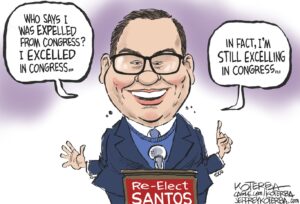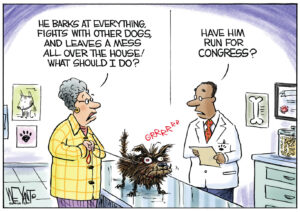Making Tragedy Out of Farce
The Senate Finance Committee's health care debate has given Michael Moore hours of footage for his next cinematic assault on the system.The Full Employment for Filmmaker Michael Moore Act is coming soon to a theater near you.
Well, not exactly.
But by exquisite coincidence, Michael Moore was in Washington this week promoting his latest comedic exposé of greed, corporate malfeasance and our government’s complicity in the unbridled assault on working America that led us into the Great Recession. “Capitalism: A Love Story” fortuitously previewed to select audiences just as the Senate Finance Committee was amending the proposed “America’s Healthy Future Act of 2009.” The panel obligingly provided hours of potential footage for Moore’s next cinematic assault on the system.
The denouement was the panel’s votes to kill proposals to create a government-sponsored insurance plan for those lacking coverage. With a public option established by the federal government, the uninsured could purchase policies that would not suddenly disappear when they got sick and that would be available in states where the insurance market is controlled by one or two big private companies. Consumers would know that profits weren’t driving the denial of care.
The arguments against allowing the equivalent of Medicare to exist alongside the private insurance system were unashamedly impenetrable. So please, follow closely.
When Democratic Sen. Chuck Schumer of New York asked Republican Sen. Chuck Grassley of Iowa if he supported Medicare — the exceedingly popular government insurance for the elderly — Grassley responded: “I think Medicare is part of the social fabric of America … just like Social Security is.” When Schumer pointed out that a public option would work the same way, Grassley persisted: Medicare, he repeated, is woven into “the social fabric.” But a similar plan available to those under age 65 would supposedly be disastrous. “The government is not a fair competitor,” Grassley said. “It’s a predator.”
Republican Sen. John Ensign of Nevada, whose support of the National Rifle Association has earned him a lifetime “A” rating from the gun lobby, argued that the adverse health effects of gun violence and auto accidents shouldn’t be considered when comparing Americans’ generally poorer health outcomes to those achieved under government-supported health systems in Europe. Overall, he says, we’re doing pretty well “if you take out auto accidents — because we drive our cars a lot more, they do public transportation.” Moreover, Ensign argued, if a government option is provided, people might like it. “When we see the effects and people like government programs,” he said, “they make them want to … survive that much more.”
The private insurance industry, it was argued, can best contain costs through competition. There is no evidence for this. Premiums for family coverage in employer-based plans have soared 131 percent over the past decade, according to the Kaiser Family Foundation. Just in the last year, family coverage premiums have climbed 5 percent, while prices for other goods have been mostly flat.
Some senators cited the Medicare Advantage program, in which private health maintenance organizations compete with traditional Medicare, as a model of efficient competition. This also was unexplained. The industry-run plans have consistently been found to cost taxpayers more per beneficiary than the government program — about 14 percent more per patient in 2009, according to the Medicare Payment Advisory Commission, an independent congressional panel. Every health overhaul plan now under consideration would cut the overpayments.
Undeterred, the Finance Committee slogged inexorably toward its intended result: to channel half a trillion dollars of taxpayer money into the private insurance industry. “They’re getting away with banditry,” complained Sen. Jay Rockefeller, the West Virginia Democrat who promoted one of the public option amendments.
Initial estimates of the finance panel’s handiwork show that about 25 million people would purchase insurance through the new “exchanges” set up in the health care reform plan. In short, the insurance industry gets 25 million new customers, many of them receiving taxpayer subsidies so they can afford the coverage. The Congressional Budget Office, in assessing an early version of the legislation, estimated that the average subsidy per enrollee would be $5,000 and the cost to taxpayers would approach $500 billion over a decade. Since then, the panel has made the subsidies more generous.
Sen. Max Baucus of Montana, the committee chairman, protested that “It’s not a subsidy to the industry. It’s dollars to people.” The people would then buy insurance from an industry whose failure to hold the line on costs has made coverage unaffordable in the first place.
I’m counting on Moore to find some humor in all of this. Otherwise what we have here is a tragedy that’s worth a good cry.
Marie Cocco’s e-mail address is mariecocco(at)washpost.com.
© 2009, Washington Post Writers Group
Your support matters…Independent journalism is under threat and overshadowed by heavily funded mainstream media.
You can help level the playing field. Become a member.
Your tax-deductible contribution keeps us digging beneath the headlines to give you thought-provoking, investigative reporting and analysis that unearths what's really happening- without compromise.
Give today to support our courageous, independent journalists.






You need to be a supporter to comment.
There are currently no responses to this article.
Be the first to respond.